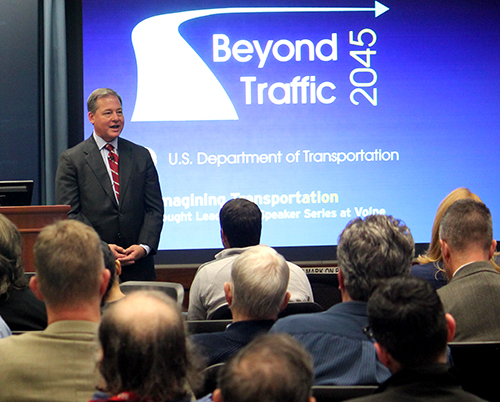Industry Disruption: How Connectivity Is Redefining Personal Mobility
Soon, there will be more people we meet in our day-to-day lives who cannot remember what life was like before ever-present Internet access. Consider how far telecommunications has come in just a few decades: from the rotary phone in 1985 to those pocket-computers we call smartphones in 2015.
“Think about the automobile industry and where we stand today, and you think there are these foundational changes that are occurring in the automobile industry that are very much kind of parallel to what the telecom industry looked like back in the 1980s,” said Harry Lightsey, executive director of the Global Connected Customer Experience for General Motors, who spoke as part of Volpe’s Reimagining Transportation series.
Technological advances are not just poised to change how we move—they are poised to change how we think about how we move, with connected vehicles already making our traveling lives safer than ever before.
“The automobile industry is making a huge pivot,” Lightsey said. “In partnership with [the National Highway Traffic Safety Administration] and DOT, we’ve gone from an era of knowing crashes were going to happen and engineering and designing vehicles to withstand the crashes. But we have a huge pivot in our industry now where we know the best crash is the one that doesn’t happen. So we’re going from crash survival to crash avoidance.”
Foundational Changes Guiding Vehicle Connectivity
 Lightsey identified four foundational changes happening in the auto industry that are connecting vehicles to each other, to infrastructure, and to us—the drivers and passengers. Beyond connectivity, these changes form the backbone of how the auto industry and consumers are rethinking what a personal vehicle looks like, and how it drives.
Lightsey identified four foundational changes happening in the auto industry that are connecting vehicles to each other, to infrastructure, and to us—the drivers and passengers. Beyond connectivity, these changes form the backbone of how the auto industry and consumers are rethinking what a personal vehicle looks like, and how it drives.
The first change in the auto industry is around awareness. With hundreds of sensors, vehicles being built today are more aware of what is going on inside and outside of the vehicle environment. Awareness makes vehicles safer, inching our cars along a continuum toward successful crash avoidance.
The second change is around intelligence. Vehicles today are incredibly intelligent computing platforms, with dozens of electronic computers that help while driving—and, with Internet access and interactive displays, computing-cars are changing how we interact with our vehicles.
The third change is in connectivity itself, with wireless communication accelerating at a great pace across the auto industry. More than 80 percent of cars by 2019 will be wirelessly connected in some way, Lightsey said. An example of this connectivity is the many vehicles that today allow drivers to upload mapping coordinates from smartphone to car.
The final change is around mobility, with engines becoming ever-more diverse, including electric and hybrid-electric cars complementing the current fleet of internal combustion vehicles.
Where Will the Next Foundational Changes Come From?
With well-established foundational changes, the question becomes: what specific disruptive technologies will drive tomorrow’s foundational changes?
Lightsey predicts that the auto industry will be in a fundamentally different place in 10 years. Just as the telecom industry was upended by forces outside that industry, he suggested that the next foundational changes may not come from one of the major auto makers.
“[In telecom] there was this guy from a whole different industry that said, ‘We can create an $800 phone that people will stand in line to get,’” Lightsey said. “And it happened. I think that’s the great thing about disruptive technology and technology transformation: it happens in ways that nobody expects.”
